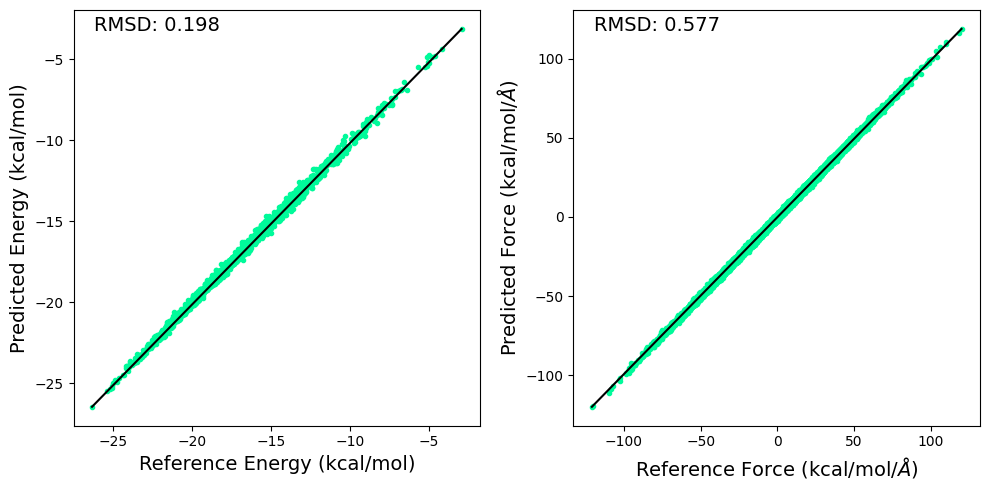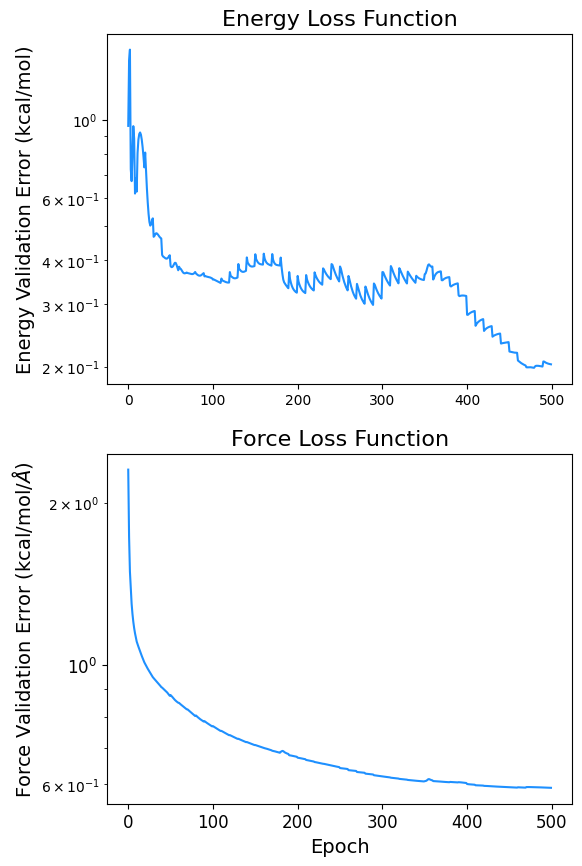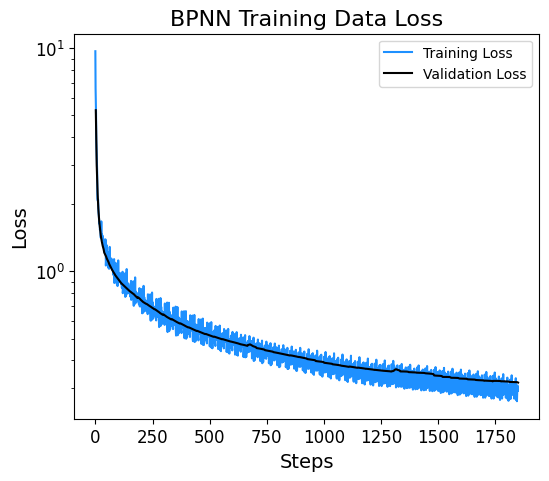3. Behler-Parrinello Symmetry Functions#
In this tutorial, we will create Behler-Parrinello and ANI neural networks using atom-centered symmetry functions. The symmetry functions will allow us to ensure that the observables (such as energy) are invariant to translations and rotations.
3.1. Importing PyTorch and Libraries#
We begin by importing PyTorch and required libraries.
%%capture
!pip install pytorch-lightning > /dev/null #installing PyTorch lightning
import math
from typing import Sequence, Tuple
import torch
import torch.nn as nn
import torch.nn.functional as F
from torch import Tensor
from torch.utils.data import TensorDataset, DataLoader, random_split
import pytorch_lightning as pl
from pytorch_lightning import loggers as pl_loggers
3.2. Symmetry Functions#
We have been using Cartesian coordinates \((x,y)\) with the Mueller-Brown potential as training data for the machine learning models. However, Cartesian coordinates are not ideal for use with neural networks because translating or rotating the molecule can change the neural network output. In the case of chemistry this would imply that translating a molecule in space changes the molecule’s energy, which is incorrect.
Instead, we can describe the Cartesian coordinates with symmetry functions and use the newly transformed coordinates as inputs, which will produce outputs that are invariant to translations and rotations.
A cutoff function and several symmetry functions were introduced by Behler and Parrinello in 2007 (https://doi.org/10.1103/PhysRevLett.98.146401).
The cutoff function is defined as:
where \(R_{ij}\) is the distance between atoms \(i\) and \(j\) and \(R_c\) is the cutoff distance.
The radial symmetry function can be defined as:
Where \(\eta\) changes the width of the Gaussian distribution and \(R_s\) shifts the center of the Gaussian peak.
The angular symmetry function can be defined as:
The angular terms are created for each set of 3 atoms as \(\cos\theta_{ijk} = \frac{\mathbf{R_{ij}}\cdot\mathbf{R_{ik}}}{R_{ij}R_{ik}}\), where \(\mathbf{R_{ij}} = \mathbf{R_{i}} - \mathbf{R_{j}}\) and gives the distance vector between atoms i and j. The \(\lambda\) parameter is set to +1,-1 to allow exploration of the angular environment at the +1 and -1 positions. The parameter \(\eta\) changes the width of the Gaussian distribution and \(\zeta\) changes the width of the Gaussians in the angular environment.
In 2017, Smith, Isayev, and Roitberg developed the ANAKIN-ME (Accurate NeurAl networK engINe for Molecular Energies), also referred to as ANI (https://doi.org/10.1039/C6SC05720A). ANI uses a modified angular symmetry function defined as:
Here, \(\theta_s\) is a parameter that allows for shifts in the angular environment and \(R_s\) allows for calculating the angular environment in radial shells by shifting the center of the Gaussians. The result is probing the angular environment at different radial lengths and angles instead of only at \(\lambda\) values of +1,-1.
3.2.1. Defining Symmetry Functions#
Now we will define the radial symmetry functions:
pairwise_vector: Distance function for calculating distances between each atom.
symmetry_function_g1: BP radial symmetry function.
symmetry_function_g2: BP angular symmetry function.
symmetry_function_g2ani: ANI angular symmetry function.
def pairwise_vector(coords: Tensor) -> Tensor:
num_batches, num_channels, _ = coords.size()
rij = coords[:, :, None] - coords[:, None]
mask = ~torch.eye(num_channels, dtype=torch.bool, device=coords.device) # remove self-interaction
rij = torch.masked_select(rij, mask.unsqueeze(2)).view(num_batches, num_channels, num_channels - 1, 3)
return rij
def symmetry_function_g1(rij: Tensor, Rcr: float, EtaR: Tensor, ShfR: Tensor) -> Tensor:
dij = torch.norm(rij, dim=3)
fij = (torch.cos(dij / Rcr * math.pi) + 1) * 0.5 *(dij <= Rcr)
g1 = torch.sum(torch.exp(-EtaR.unsqueeze(dim=1) * (dij.unsqueeze(dim=-1) - ShfR.unsqueeze(dim=1))**2) * fij.unsqueeze(dim=-1), dim=2)
return g1
def symmetry_function_g2(rij: Tensor, Rca: float, Zeta: Tensor, EtaA: Tensor, LamA: Tensor) -> Tensor:
c = torch.combinations(torch.arange(rij.size(2)), r=2)
rij = rij[:, :, c]
r12 = rij[:, :, :, 0]
r13 = rij[:, :, :, 1]
r23 = r12 - r13
d12 = torch.norm(r12, dim=3)
d13 = torch.norm(r13, dim=3)
d23 = torch.norm(r23, dim=3)
f12 = (torch.cos(d12 / Rca * math.pi) + 1) * 0.5
f13 = (torch.cos(d13 / Rca * math.pi) + 1) * 0.5
f23 = (torch.cos(d23 / Rca * math.pi) + 1) * 0.5
cosine = torch.einsum('ijkl,ijkl->ijk', r12, r13) / (d12 * d13)
g2 = torch.sum(2**(1 - Zeta.unsqueeze(dim=1)) * (1 + LamA.unsqueeze(dim=1) * cosine.unsqueeze(dim=-1))**Zeta.unsqueeze(dim=1) * torch.exp(-EtaA.unsqueeze(dim=1) * (d12**2 + d13**2 + d23**2).unsqueeze(dim=-1)) * (f12 * f13 * f23).unsqueeze(dim=-1), dim=2)
return g2
def symmetry_function_g2ani(rij: Tensor, Rca: float, Zeta: Tensor, ShfZ: Tensor, EtaA: Tensor, ShfA: Tensor) -> Tensor:
c = torch.combinations(torch.arange(rij.size(2)), r=2)
rij = rij[:, :, c]
r12 = rij[:, :, :, 0]
r13 = rij[:, :, :, 1]
r23 = r12 - r13
d12 = torch.norm(r12, dim=3)
d13 = torch.norm(r13, dim=3)
f12 = (torch.cos(d12 / Rca * math.pi) + 1) * 0.5
f13 = (torch.cos(d13 / Rca * math.pi) + 1) * 0.5
cosine = torch.einsum('ijkl,ijkl->ijk', r12, r13) / (d12 * d13)
cosine = torch.cos(torch.acos(cosine).unsqueeze(dim=-1) - ShfA.unsqueeze(dim=1))
g2 = torch.sum(2**(1 - Zeta.unsqueeze(dim=1)) * (1 + cosine)**Zeta.unsqueeze(dim=1) * torch.exp(-EtaA.unsqueeze(dim=1) * (0.5 * (d12 + d13).unsqueeze(dim=-1) - ShfZ.unsqueeze(dim=1))**2) * (f12 * f13).unsqueeze(dim=-1), dim=2)
return g2
3.3. Defining Neural Network and Feature Extraction Classes#
We will now define feature extraction classes which will be used in our Behler-Parrinello and ANI neural networks.
3.3.1. Defining Sequential and Dense Classes#
The Sequential class contains the function for the feed-forward aspect of our neural network. The Dense class contains functions to describe a densely connected neural network.
class Sequential(nn.Sequential):
def forward(self, input: Tuple[Tensor, Tensor]) -> Tuple[Tensor, Tensor]:
for module in self:
input = module(input)
return input
class Dense(nn.Module):
def __init__(self, num_channels: int, in_features: int, out_features: int, bias: bool = True, activation: bool = False, residual: bool = False) -> None:
super().__init__()
self.num_channels = num_channels
self.in_features = in_features
self.out_features = out_features
self.weight = nn.Parameter(torch.Tensor(num_channels, out_features, in_features))
if bias:
self.bias = nn.Parameter(torch.Tensor(num_channels, out_features))
else:
self.register_parameter('bias', None)
self.activation = activation
self.residual = residual
self.reset_parameters()
def reset_parameters(self) -> None:
for w in self.weight:
nn.init.kaiming_uniform_(w, a=math.sqrt(5))
if self.bias is not None:
for b, w in zip(self.bias, self.weight):
fan_in, _ = nn.init._calculate_fan_in_and_fan_out(w)
bound = 1 / math.sqrt(fan_in)
nn.init.uniform_(b, -bound, bound)
def forward(self, input: Tuple[Tensor, Tensor]) -> Tuple[Tensor, Tensor]:
x, channels = input
weight: Tensor = self.weight[channels]
output: Tensor = torch.bmm(x.transpose(0, 1), weight.transpose(1, 2)).transpose(0, 1)
if self.bias is not None:
bias = self.bias[channels]
output = output + bias
if self.activation:
output = torch.tanh(output)
if self.residual:
if output.shape[2] == x.shape[2]:
output = output + x
elif output.shape[2] == x.shape[2] * 2:
output = output + torch.cat([x, x], dim=2)
else:
raise NotImplementedError("Not implemented")
return output, channels
def extra_repr(self) -> str:
return 'num_channels={}, in_features={}, out_features={}, bias={}, activation={}, residual={}'.format(
self.num_channels, self.in_features, self.out_features, self.bias is not None, self.activation, self.residual
)
3.3.2. Creating the Feature Class#
Now we will create the feature class, which takes input information and uses functions to extract characteristics unique to the called input features. Here we will be using the previously defined symmetry functions for feature extraction.
class Feature(nn.Module):
def __init__(self, Rcr: float, EtaR: Tensor, ShfR: Tensor, Rca: float, Zeta: Tensor, EtaA: Tensor, LamA: Tensor) -> None:
super().__init__()
assert len(EtaR) == len(ShfR)
assert len(Zeta) == len(EtaA)
self.Rcr = Rcr
self.Rca = Rca
self.EtaR = torch.Tensor(EtaR)
self.ShfR = torch.Tensor(ShfR)
self.Zeta = torch.Tensor(Zeta)
self.EtaA = torch.Tensor(EtaA)
self.LamA = torch.Tensor(LamA)
def forward(self, coords: Tensor, atom_types: Tensor) -> Tensor:
num_batches, num_channels, _ = coords.size()
rij = pairwise_vector(coords)
EtaR = self.EtaR.to(device=coords.device)[atom_types]
ShfR = self.ShfR.to(device=coords.device)[atom_types]
Zeta = self.Zeta.to(device=coords.device)[atom_types]
EtaA = self.EtaA.to(device=coords.device)[atom_types]
LamA = self.LamA.to(device=coords.device)[atom_types]
g1 = symmetry_function_g1(rij, self.Rcr, EtaR, ShfR)
g2 = symmetry_function_g2(rij, self.Rca, Zeta, EtaA, LamA)
return torch.concat((g1, g2), dim=2)
@property
def output_length(self) -> int:
return len(self.EtaR[0]) + len(self.EtaA[0])
3.3.3. Creating the Feature Class for ANI#
We will create a similar feature class for ANI that uses the ANI angle symmetry function.
class FeatureANI(nn.Module):
def __init__(self, Rcr: float, EtaR: Tensor, ShfR: Tensor, Rca: float, Zeta: Tensor, ShfZ: Tensor, EtaA: Tensor, ShfA: Tensor) -> None:
super().__init__()
assert len(EtaR) == len(ShfR)
assert len(Zeta) == len(ShfZ) == len(EtaA) == len(ShfA)
self.Rcr = Rcr
self.Rca = Rca
self.EtaR = torch.Tensor(EtaR)
self.ShfR = torch.Tensor(ShfR)
self.Zeta = torch.Tensor(Zeta)
self.ShfZ = torch.Tensor(ShfZ)
self.EtaA = torch.Tensor(EtaA)
self.ShfA = torch.Tensor(ShfA)
def forward(self, coords: Tensor, atom_types: Tensor) -> Tensor:
num_batches, num_channels, _ = coords.size()
rij = pairwise_vector(coords)
EtaR = self.EtaR.to(device=coords.device)[atom_types]
ShfR = self.ShfR.to(device=coords.device)[atom_types]
Zeta = self.Zeta.to(device=coords.device)[atom_types]
ShfZ = self.ShfZ.to(device=coords.device)[atom_types]
EtaA = self.EtaA.to(device=coords.device)[atom_types]
ShfA = self.ShfA.to(device=coords.device)[atom_types]
g1 = symmetry_function_g1(rij, self.Rcr, EtaR, ShfR)
g2 = symmetry_function_g2ani(rij, self.Rca, Zeta, ShfZ, EtaA, ShfA)
return torch.concat((g1, g2), dim=2)
@property
def output_length(self) -> int:
return len(self.EtaR[0]) + len(self.EtaA[0])
3.3.4. Creating the Fitting Class#
Now we create the fitting class, which will use the dense neural network for fitting.
class Fitting(nn.Module):
def __init__(self, n_types: int, in_features: int, neuron: Sequence[int] = [240, 240, 240]) -> None:
super().__init__()
layers = [Dense(n_types, in_features, neuron[0], activation=True)]
for i in range(len(neuron)-1):
layers.append(Dense(n_types, neuron[i], neuron[i+1], activation=True, residual=True)) # iterating through the neurons
layers.append(Dense(n_types, neuron[-1], 1))
self.fitting_net = Sequential(*layers)
def forward(self, input : Tuple[Tensor, Tensor]) -> Tensor:
output, _ = self.fitting_net(input)
return output
3.3.5. Create the Behler-Parrinello Neural Network (BPNN) Class#
Finally, we will now create the BPNN class that can be used for training with the symmetry functions.
class BPNN(pl.LightningModule):
def __init__(self, descriptor: nn.Module, fitting_net: nn.Module, learning_rate=5e-4) -> None:
super().__init__()
self.descriptor = descriptor
self.fitting_net = fitting_net
self.learning_rate = learning_rate
def forward(self, coords: torch.Tensor, atom_types: torch.Tensor):
coords.requires_grad_()
descriptors = self.descriptor(coords, atom_types)
atomic_energies = self.fitting_net((descriptors, atom_types))
energy = torch.unbind(torch.sum(atomic_energies, dim=1))
gradient, = torch.autograd.grad(energy, [coords], create_graph=True)
return torch.hstack(energy), gradient
def training_step(self, batch, batch_idx):
qm_coord, atom_types, energy, gradient = batch
ene_pred, grad_pred = self(qm_coord, atom_types[0]) # training the energy and gradient predictions
ene_loss = F.mse_loss(ene_pred, energy) # defining loss functions for energy and gradient predictions
grad_loss = F.mse_loss(grad_pred, gradient)
lr = self.optimizers().optimizer.param_groups[0]['lr']
start_lr = self.optimizers().optimizer.param_groups[0]['initial_lr']
w_ene = 1
w_grad = 1 + 99 * (lr / start_lr)
loss = w_ene / (w_ene + w_grad) * ene_loss + w_grad / (w_ene + w_grad) * grad_loss
self.log('train_loss', loss)
self.log('l2_trn', torch.sqrt(loss))
self.log('l2_e_trn', torch.sqrt(ene_loss))
self.log('l2_f_trn', torch.sqrt(grad_loss))
return loss
def validation_step(self, batch, batch_idx):
torch.set_grad_enabled(True)
qm_coord, atom_types, energy, gradient = batch
ene_pred, grad_pred = self(qm_coord, atom_types[0])
ene_loss = F.mse_loss(ene_pred, energy)
grad_loss = F.mse_loss(grad_pred, gradient)
lr = self.optimizers().optimizer.param_groups[0]['lr']
start_lr = self.optimizers().optimizer.param_groups[0]['initial_lr']
w_ene = 1
w_grad = 1 + 99 * (lr / start_lr)
loss = w_ene / (w_ene + w_grad) * ene_loss + w_grad / (w_ene + w_grad) * grad_loss
self.log('val_loss', loss)
self.log('l2_tst', torch.sqrt(loss))
self.log('l2_e_tst', torch.sqrt(ene_loss))
self.log('l2_f_tst', torch.sqrt(grad_loss))
self.log('lr', lr)
return loss
def configure_optimizers(self):
optimizer = torch.optim.Adam(self.parameters(), lr=self.learning_rate)
scheduler = {'scheduler': torch.optim.lr_scheduler.ExponentialLR(optimizer, 0.95),
'interval': 'epoch',
'frequency': 10,
}
return [optimizer], [scheduler]
3.4. Loading Data#
Files from GitHub:
Coordinates and atom types:
qm_coord.npy (1800, 14, 3)
qm_elem.txt ([6, 6, 6, 6, 1, 1, 1, 1, 1, 1, 1, 1, 1, 1])
PM3 energies and gradients:
energy_sqm.npy (1800,)
qm_grad_sqm.npy (1800, 14, 3)
B3LYP/6-31+G* energies and gradients:
energy.npy (1800,)
qm_grad.npy (1800, 14, 3)
These files will provide us with semi-empirical (PM3) and QM (B3LYP/6-31+G*) data to train our machine learning model.
import numpy as np
ds = np.DataSource(None)
qm_coord = np.array(np.load(ds.open("https://github.com/cc-ats/mlp_tutorial/raw/main/Butane/qm_coord.npy", "rb")), dtype="float32")
atom_types = np.loadtxt(ds.open("https://github.com/cc-ats/mlp_tutorial/raw/main/Butane/qm_elem.txt", "r"), dtype=int)
elems = np.unique(atom_types).tolist()
atom_types = np.array([[elems.index(i) for i in atom_types]])
atom_types = atom_types.repeat(len(qm_coord), axis=0)
energy = np.array((np.load(ds.open("https://github.com/cc-ats/mlp_tutorial/raw/main/Butane/energy.npy", "rb")) - np.load(ds.open("https://github.com/cc-ats/mlp_tutorial/raw/main/Butane/energy_sqm.npy", "rb"))) * 27.2114 * 23.061, dtype="float32")
energy = energy - energy.mean()
qm_gradient = np.array((np.load(ds.open("https://github.com/cc-ats/mlp_tutorial/raw/main/Butane/qm_grad.npy", "rb")) - np.load(ds.open("https://github.com/cc-ats/mlp_tutorial/raw/main/Butane/qm_grad_sqm.npy", "rb"))) * 27.2114 * 23.061 / 0.529177249, dtype="float32")
device = torch.device('cuda' if torch.cuda.is_available() else 'cpu')
qm_coord = torch.from_numpy(qm_coord).to(device)
atom_types = torch.from_numpy(atom_types).to(device)
energy = torch.from_numpy(energy).to(device)
qm_gradient = torch.from_numpy(qm_gradient).to(device)
pl.seed_everything(2)
dataset = TensorDataset(qm_coord, atom_types, energy, qm_gradient)
train, val = random_split(dataset, [1728, 72])
# Training Set Size: 1728 (96%)
# Test Set Size: 72 ( 4%)
# Data Set Size: 1780
train_loader = DataLoader(train, batch_size=32)
val_loader = DataLoader(val, batch_size=32)
INFO:lightning_fabric.utilities.seed:Global seed set to 2
3.5. Using ANI for Feature Extraction#
Here is an example where we use the ANI model for feature extraction. We will use values for the symmetry function parameters from the ASE_ANI model references (isayev/ASE_ANI), which serves as an interface for the TorchANI (https://doi.org/10.1021/acs.jcim.0c00451) software package. The BP parameters in this tutorial are not optimized for this system. The parameters can be optimized following the procedures outlined in https://doi.org/10.1002/qua.24890.
%%capture
%%time
pl.seed_everything(2)
ani = True
if ani:
# From TorchANI
Rcr = 5.2000e+00
Rca = 3.5000e+00
EtaR = [1.6000000e+01]
ShfR = [9.0000000e-01,1.1687500e+00,1.4375000e+00,1.7062500e+00,1.9750000e+00,2.2437500e+00,2.5125000e+00,2.7812500e+00,3.0500000e+00,3.3187500e+00,3.5875000e+00,3.8562500e+00,4.1250000e+00,4.3937500e+00,4.6625000e+00,4.9312500e+00]
Zeta = [3.2000000e+01]
ShfZ = [1.9634954e-01,5.8904862e-01,9.8174770e-01,1.3744468e+00,1.7671459e+00,2.1598449e+00,2.5525440e+00,2.9452431e+00]
EtaA = [8.0000000e+00]
ShfA = [9.0000000e-01,1.5500000e+00,2.2000000e+00,2.8500000e+00]
# Make every combination of EtaR and ShfR with meshgrid
EtaR, ShfR = np.array(np.meshgrid(EtaR, ShfR)).reshape(2, -1)
# Make every combination of Zeta, ShfZ, EtaA, and ShfA with meshgrid
Zeta, ShfZ, EtaA, ShfA = np.array(np.meshgrid(Zeta, ShfZ, EtaA, ShfA)).reshape(4, -1)
EtaR = np.repeat([EtaR], 3, axis=0)
ShfR = np.repeat([ShfR], 3, axis=0)
Zeta = np.repeat([Zeta], 3, axis=0)
ShfZ = np.repeat([ShfZ], 3, axis=0)
EtaA = np.repeat([EtaA], 3, axis=0)
ShfA = np.repeat([ShfA], 3, axis=0)
descriptor = FeatureANI(Rcr, EtaR, ShfR, Rca, Zeta, ShfZ, EtaA, ShfA)
else:
Rcr = 6.0
Rca = 6.0
ShfR = np.zeros((3,6)) # H, C, O
EtaR = [0.0, 0.04, 0.14, 0.32, 0.71, 1.79]
EtaR = np.repeat([EtaR], 3, axis=0) # H, C, O
Zeta = [1, 2, 4, 8, 16, 32, 1, 2, 4, 8, 16, 32]
Zeta = np.repeat([Zeta], 3, axis=0) # H, C, O
EtaA = [0.0, 0.04, 0.14, 0.32, 0.71, 1.79, 0.0, 0.04, 0.14, 0.32, 0.71, 1.79]
EtaA = np.repeat([EtaA], 3, axis=0) # H, C, O
LamA = [1, 1, 1, 1, 1, 1, -1, -1, -1, -1, -1, -1]
LamA = np.repeat([LamA], 3, axis=0) # H, C, O
descriptor = Feature(Rcr, EtaR, ShfR, Rca, Zeta, EtaA, LamA)
fitting_net = Fitting(3, descriptor.output_length, neuron=[240, 240, 240])
model = BPNN(descriptor, fitting_net, learning_rate=5e-4)
csv_logger = pl_loggers.CSVLogger('logs_csv/')
trainer = pl.Trainer(max_epochs=500, logger=csv_logger, log_every_n_steps=20, accelerator='auto')
trainer.fit(model, train_loader, val_loader)
model.to(device)
INFO:lightning_fabric.utilities.seed:Global seed set to 2
INFO:pytorch_lightning.utilities.rank_zero:GPU available: True (cuda), used: True
INFO:pytorch_lightning.utilities.rank_zero:TPU available: False, using: 0 TPU cores
INFO:pytorch_lightning.utilities.rank_zero:IPU available: False, using: 0 IPUs
INFO:pytorch_lightning.utilities.rank_zero:HPU available: False, using: 0 HPUs
INFO:pytorch_lightning.accelerators.cuda:LOCAL_RANK: 0 - CUDA_VISIBLE_DEVICES: [0]
INFO:pytorch_lightning.callbacks.model_summary:
| Name | Type | Params
-------------------------------------------
0 | descriptor | FeatureANI | 0
1 | fitting_net | Fitting | 383 K
-------------------------------------------
383 K Trainable params
0 Non-trainable params
383 K Total params
1.532 Total estimated model params size (MB)
INFO:pytorch_lightning.utilities.rank_zero:`Trainer.fit` stopped: `max_epochs=500` reached.
3.6. Saving the Model with PyTorch Files and Evaluating the Model’s Accuracy Using RMSD#
3.6.1. Saving the Model with PyTorch#
The following files will be saved:
1) model.pt
torch.save saves tensors to model.pt
2) model_script.pt
torch.jit.save attempts to preserve the behavior of some operators across PyTorch versions.
Previously saved models can be loaded with:
model.load_state_dict(torch.load(”model.pt”))
torch.jit.load(“model_script.pt”)
torch.save(model.state_dict(), 'model.pt')
torch.jit.save(model.to_torchscript(), "model_script.pt")
ene_pred, grad_pred = model(qm_coord, atom_types[0])
3.6.2. Plotting RMSD to Evaluate the Energy and Force Predictions of the Model#
RMSD for predicted and reference energy and forces are calculated and displayed below.
import matplotlib.pyplot as plt
fig, ax = plt.subplots(1,2,figsize=(10,5))
ds = np.DataSource(None)
e1 = energy.cpu().detach().numpy() + np.load(ds.open("https://github.com/cc-ats/mlp_tutorial/raw/main/Butane/energy_sqm.npy","rb")) * 27.2114 * 23.061
e2 = ene_pred.cpu().detach().numpy() + np.load(ds.open("https://github.com/cc-ats/mlp_tutorial/raw/main/Butane/energy_sqm.npy","rb")) * 27.2114 * 23.061
ax[0].plot(e1, e2, linestyle='none', marker='.',color='mediumspringgreen')
ax[0].plot([np.max(e1), np.min(e1)], [np.max(e2), np.min(e2)] , color="k", linewidth=1.5)
ax[0].set_xlabel("Reference Energy (kcal/mol)", size=14)
ax[0].set_ylabel("Predicted Energy (kcal/mol)", size=14)
ax[0].annotate('RMSD: %.3f' % np.sqrt(np.mean((e1 - e2)**2)), xy=(0.05, 0.95), xycoords='axes fraction', size=14)
f1 = -qm_gradient.cpu().detach().numpy().reshape(-1) - np.load(ds.open("https://github.com/cc-ats/mlp_tutorial/raw/main/Butane/qm_grad_sqm.npy","rb")).reshape(-1) * 27.2114 * 23.061 / 0.529177249
f2 = -grad_pred.cpu().detach().numpy().reshape(-1) - np.load(ds.open("https://github.com/cc-ats/mlp_tutorial/raw/main/Butane/qm_grad_sqm.npy","rb")).reshape(-1) * 27.2114 * 23.061 / 0.529177249
ax[1].plot(f1, f2, linestyle='none', marker='.',color='mediumspringgreen')
ax[1].plot([np.max(f1), np.min(f1)], [np.max(f2), np.min(f2)] , color="k", linewidth=1.5)
ax[1].set_xlabel(r'Reference Force (kcal/mol/$\AA$)', size=14)
ax[1].set_ylabel(r'Predicted Force (kcal/mol/$\AA$)', size=14)
ax[1].annotate('RMSD: %.3f' % np.sqrt(np.mean((f1 - f2)**2)), xy=(0.05, 0.95), xycoords='axes fraction', size=14)
plt.tight_layout()
plt.savefig('rmsd.png', dpi=300)

3.6.3. The Model Weights and Biases Dictionary#
This cell prints the size of the weights and biases used in the trained model for reference.
print("Model's state_dict:")
for param_tensor in model.state_dict():
print(f'{param_tensor:<33}\t{model.state_dict()[param_tensor].size()}')
Model's state_dict:
fitting_net.fitting_net.0.weight torch.Size([3, 240, 48])
fitting_net.fitting_net.0.bias torch.Size([3, 240])
fitting_net.fitting_net.1.weight torch.Size([3, 240, 240])
fitting_net.fitting_net.1.bias torch.Size([3, 240])
fitting_net.fitting_net.2.weight torch.Size([3, 240, 240])
fitting_net.fitting_net.2.bias torch.Size([3, 240])
fitting_net.fitting_net.3.weight torch.Size([3, 1, 240])
fitting_net.fitting_net.3.bias torch.Size([3, 1])
3.7. Plotting the Minimization of the Loss Function#
import pandas as pd
data = pd.read_csv(f'logs_csv/lightning_logs/version_{csv_logger.version}/metrics.csv')
fig, ax = plt.subplots(2, figsize=(6,10))
x = data['epoch'][~data['l2_e_tst'].isnull()]
y = data['l2_e_tst'][~data['l2_e_tst'].isnull()]
y2 = data['l2_f_tst'][~data['l2_f_tst'].isnull()]
ax[0].semilogy(x, y,color='dodgerblue')
ax[0].set_ylabel('Energy Validation Error (kcal/mol)', fontsize=14)
ax[0].set_title('Energy Loss Function', fontsize=16)
ax[1].semilogy(x, y2, label='Force Validation Error (kcal/mol',color='dodgerblue')
ax[1].set_xlabel('Epoch', fontsize=14)
ax[1].set_ylabel(r'Force Validation Error (kcal/mol/$\AA$)', fontsize=14)
ax[1].set_title('Force Loss Function', fontsize=16)
plt.xticks(fontsize=12)
plt.yticks(fontsize=12)
fig.savefig('loss.png', dpi=300)

3.8. Plotting Training and Validation Loss#
The loss at each step of the training process is displayed below.
data = pd.read_csv(f'logs_csv/lightning_logs/version_{csv_logger.version}/metrics.csv')
fig, ax = plt.subplots(figsize=(6,5))
x = data['epoch'][~data['epoch'].isnull()]
y = data['train_loss'][~data['train_loss'].isnull()]
print('Size of the Training Set:', len(y))
plt.semilogy(y, label='Training Loss',color='dodgerblue')
y = data['val_loss'][~data['val_loss'].isnull()]
print('Size of the Validation Set:', len(y))
plt.semilogy(y, label='Validation Loss',color='k')
plt.xlabel('Steps', fontsize=14)
plt.ylabel('Loss', fontsize=14)
plt.xticks(fontsize=12)
plt.yticks(fontsize=12)
plt.title('BPNN Training Data Loss', fontsize=16)
plt.legend()
plt.show()
Size of the Training Set: 1350
Size of the Validation Set: 500

